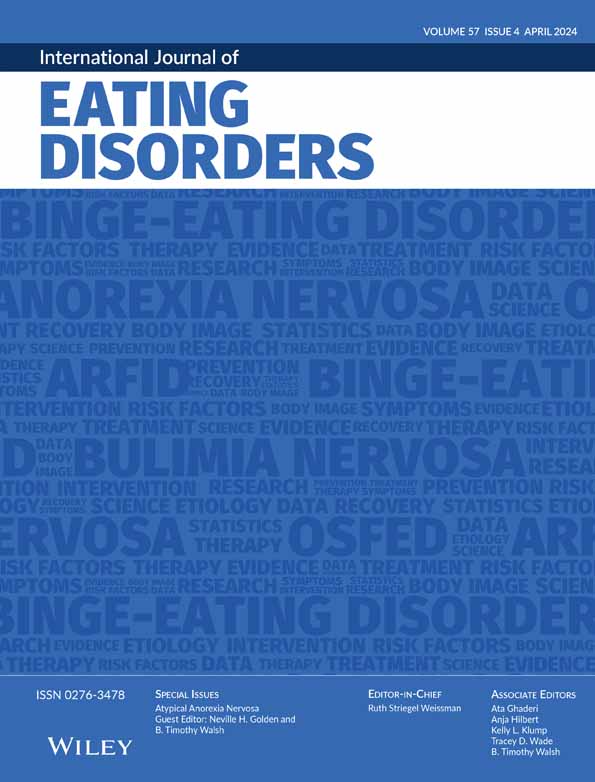Eating disorder psychopathology, psychiatric impairment, and symptom frequency of atypical anorexia nervosa versus anorexia nervosa: A systematic review and meta-analysis
Abstract
enObjectives
Restrictive eating disorders (EDs) occur across the weight spectrum, but historically more focus has been given to anorexia nervosa (AN) than atypical anorexia nervosa (atypAN). AtypAN's relegation to a diagnosis in the “other specified feeding and eating disorder” (OSFED) category and paucity of research surrounding atypAN invariably implies a less clinically severe ED. However, a growing body of research has begun to question the assumption that atypAN is less severe than AN. The current review and meta-analysis aimed to provide a comprehensive review to compare atypAN and AN on measures of eating disorder psychopathology, impairment, and symptom frequency to test whether atypAN is truly less clinically severe than AN.
Methods
Twenty articles that reported on atypAN and AN for at least one of the variables of interest were retrieved from PsycInfo, PubMed, and ProQuest.
Results
For eating-disorder psychopathology, results indicated that differences were nonsignificant for most indicators; however, atypAN was associated with significantly higher shape concern, weight concern, drive for thinness, body dissatisfaction, and overall eating-disorder psychopathology than AN. Results indicated that atypAN and AN did not significantly differ on clinical impairment or the frequency of inappropriate compensatory behaviors, whereas there was a significantly higher frequency of objective binge episodes in AN (vs. atypAN).
Discussion
Overall, findings indicated that, in contrast to the current classification system, atypAN and AN were not clinically distinct. Results underscore the need for equal access to treatment and equal insurance coverage for restrictive EDs across the weight spectrum.
Public Significance
The current meta-analysis found that atypAN was associated with higher drive for thinness, body dissatisfaction, shape concern, weight concern, and overall eating-disorder psychopathology than AN; whereas AN was associated with higher frequency of objective binge eating. Individuals with AN and atypAN did not differ on psychiatric impairment, quality-of-life, or frequency of compensatory behaviors, highlighting the need for equal access to care for restrictive EDs across the weight spectrum.
Resumen
esObjetivo
Los trastornos alimentarios restrictivos ocurren en todo el espectro de peso, pero históricamente se ha dado más importancia a la anorexia nerviosa (AN) que a la anorexia nerviosa atípica (ANA). El hecho de relegar la anorexia nerviosa atípica a un diagnóstico en la categoría de "otro trastorno de la ingestión de alimentos y de la conducta alimentaria" (OSFED) y la escasez de investigación en torno a la anorexia atípica, implica invariablemente un trastorno de la conducta alimentaria clínicamente menos grave. Sin embargo, un creciente cuerpo de investigación ha comenzado a cuestionar la suposición de que ANA es menos grave que AN. La revisión actual y el metanálisis tuvieron como objetivo proporcionar una revisión exhaustiva para comparar ANA y AN en las medidas de psicopatología de los trastornos alimentarios, el deterioro y la frecuencia de los síntomas para probar si ANA es realmente menos grave clínicamente que AN.
Método
Veinte artículos que informaron sobre ANA y AN para al menos una de las variables de interés se recuperaron de PsycInfo, PubMed y ProQuest.
Resultados
Para la psicopatología del trastorno alimentario, los resultados indicaron que las diferencias no fueron significativas para la mayoría de los indicadores; sin embargo, ANA se asoció con una preocupación de forma significativamente mayor, preocupación por el peso, impulso por la delgadez, insatisfacción corporal y psicopatología general del trastorno alimentario que AN. Los resultados indicaron que ANA y AN no difirieron significativamente en el deterioro clínico o la frecuencia de comportamientos compensatorios inapropiados, mientras que hubo una frecuencia significativamente mayor de episodios de atracones objetivos en AN (frente a ANA).
Discusión
En general, los hallazgos indicaron que, en contraste con el sistema de clasificación actual, ANA y AN no eran clínicamente distintos. Los resultados subrayan la necesidad de un acceso equitativo al tratamiento y una cobertura de seguro igual para los trastornos de la conducta alimentaria restrictivos en todo el espectro de peso.
CONFLICT OF INTEREST STATEMENT
The authors declare that they have no conflict of interest.
Open Research
DATA AVAILABILITY STATEMENT
The data that support the findings of this study are available from the corresponding author upon reasonable request.




